Leadership & Management: Problem Solving, Data Analysis, & Risk Plans
VerifiedAdded on 2023/06/10
|10
|2223
|280
Homework Assignment
AI Summary
This assignment delves into various aspects of leadership and management, addressing problem-solving methodologies, data analysis techniques, and strategic decision-making processes. It covers a 5-step approach to solving business problems, emphasizing understanding the problem, identifying root causes, and implementing solutions. The assignment also discusses methods for ensuring data reliability, testing data validity, and collecting staff feedback through questionnaires. Furthermore, it explores statistical data analysis, sensitivity analysis, and the use of quantitative data analysis models in decision-making. The importance of risk management plans and the involvement of employees and managers in decision-making are highlighted, along with the significance of maintaining corporate knowledge. Emerging technologies like Big Data and cloud computing for knowledge management are also mentioned. The document concludes by touching upon statistical analysis methods for quantitative research and the role of information systems in knowledge circulation. Desklib offers this assignment and many other resources to aid students in their studies.

Running head: LEADERSHIP AND MANAGEMENT
LEADERSHIP AND MANAGEMENT
Name of the student
Name of the university
Author note
LEADERSHIP AND MANAGEMENT
Name of the student
Name of the university
Author note
Paraphrase This Document
Need a fresh take? Get an instant paraphrase of this document with our AI Paraphraser
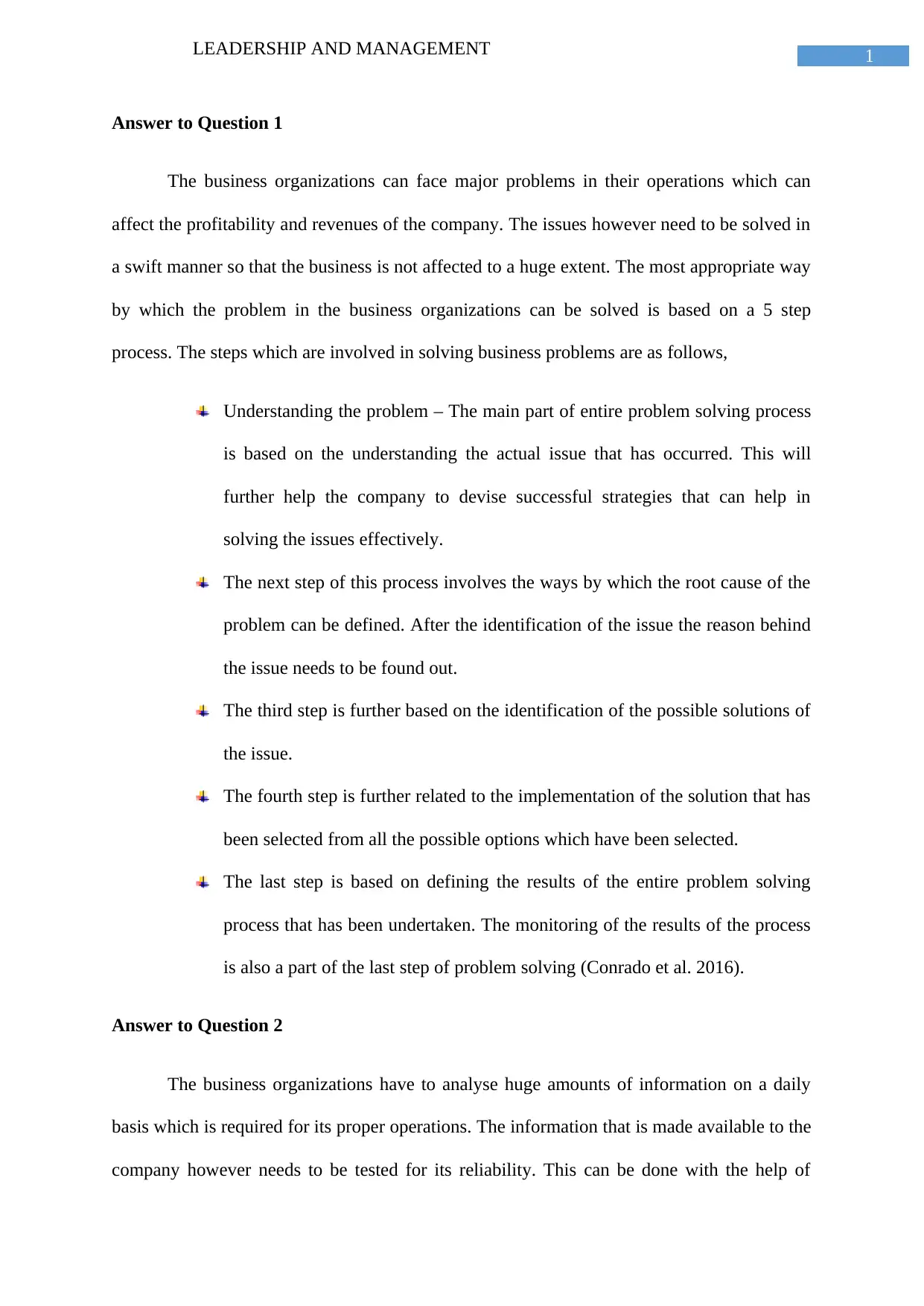
1LEADERSHIP AND MANAGEMENT
Answer to Question 1
The business organizations can face major problems in their operations which can
affect the profitability and revenues of the company. The issues however need to be solved in
a swift manner so that the business is not affected to a huge extent. The most appropriate way
by which the problem in the business organizations can be solved is based on a 5 step
process. The steps which are involved in solving business problems are as follows,
Understanding the problem – The main part of entire problem solving process
is based on the understanding the actual issue that has occurred. This will
further help the company to devise successful strategies that can help in
solving the issues effectively.
The next step of this process involves the ways by which the root cause of the
problem can be defined. After the identification of the issue the reason behind
the issue needs to be found out.
The third step is further based on the identification of the possible solutions of
the issue.
The fourth step is further related to the implementation of the solution that has
been selected from all the possible options which have been selected.
The last step is based on defining the results of the entire problem solving
process that has been undertaken. The monitoring of the results of the process
is also a part of the last step of problem solving (Conrado et al. 2016).
Answer to Question 2
The business organizations have to analyse huge amounts of information on a daily
basis which is required for its proper operations. The information that is made available to the
company however needs to be tested for its reliability. This can be done with the help of
Answer to Question 1
The business organizations can face major problems in their operations which can
affect the profitability and revenues of the company. The issues however need to be solved in
a swift manner so that the business is not affected to a huge extent. The most appropriate way
by which the problem in the business organizations can be solved is based on a 5 step
process. The steps which are involved in solving business problems are as follows,
Understanding the problem – The main part of entire problem solving process
is based on the understanding the actual issue that has occurred. This will
further help the company to devise successful strategies that can help in
solving the issues effectively.
The next step of this process involves the ways by which the root cause of the
problem can be defined. After the identification of the issue the reason behind
the issue needs to be found out.
The third step is further based on the identification of the possible solutions of
the issue.
The fourth step is further related to the implementation of the solution that has
been selected from all the possible options which have been selected.
The last step is based on defining the results of the entire problem solving
process that has been undertaken. The monitoring of the results of the process
is also a part of the last step of problem solving (Conrado et al. 2016).
Answer to Question 2
The business organizations have to analyse huge amounts of information on a daily
basis which is required for its proper operations. The information that is made available to the
company however needs to be tested for its reliability. This can be done with the help of
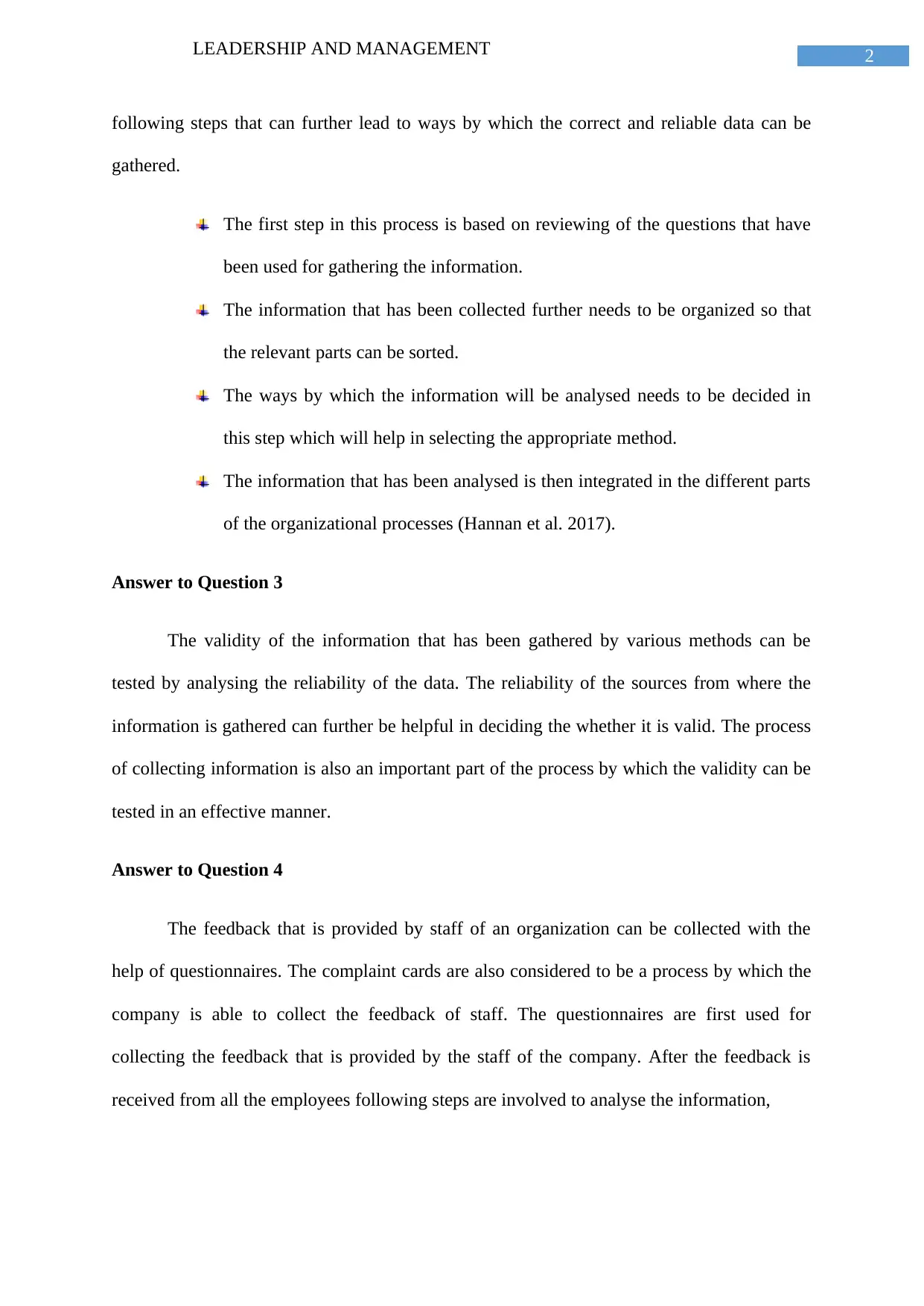
2LEADERSHIP AND MANAGEMENT
following steps that can further lead to ways by which the correct and reliable data can be
gathered.
The first step in this process is based on reviewing of the questions that have
been used for gathering the information.
The information that has been collected further needs to be organized so that
the relevant parts can be sorted.
The ways by which the information will be analysed needs to be decided in
this step which will help in selecting the appropriate method.
The information that has been analysed is then integrated in the different parts
of the organizational processes (Hannan et al. 2017).
Answer to Question 3
The validity of the information that has been gathered by various methods can be
tested by analysing the reliability of the data. The reliability of the sources from where the
information is gathered can further be helpful in deciding the whether it is valid. The process
of collecting information is also an important part of the process by which the validity can be
tested in an effective manner.
Answer to Question 4
The feedback that is provided by staff of an organization can be collected with the
help of questionnaires. The complaint cards are also considered to be a process by which the
company is able to collect the feedback of staff. The questionnaires are first used for
collecting the feedback that is provided by the staff of the company. After the feedback is
received from all the employees following steps are involved to analyse the information,
following steps that can further lead to ways by which the correct and reliable data can be
gathered.
The first step in this process is based on reviewing of the questions that have
been used for gathering the information.
The information that has been collected further needs to be organized so that
the relevant parts can be sorted.
The ways by which the information will be analysed needs to be decided in
this step which will help in selecting the appropriate method.
The information that has been analysed is then integrated in the different parts
of the organizational processes (Hannan et al. 2017).
Answer to Question 3
The validity of the information that has been gathered by various methods can be
tested by analysing the reliability of the data. The reliability of the sources from where the
information is gathered can further be helpful in deciding the whether it is valid. The process
of collecting information is also an important part of the process by which the validity can be
tested in an effective manner.
Answer to Question 4
The feedback that is provided by staff of an organization can be collected with the
help of questionnaires. The complaint cards are also considered to be a process by which the
company is able to collect the feedback of staff. The questionnaires are first used for
collecting the feedback that is provided by the staff of the company. After the feedback is
received from all the employees following steps are involved to analyse the information,
⊘ This is a preview!⊘
Do you want full access?
Subscribe today to unlock all pages.

Trusted by 1+ million students worldwide
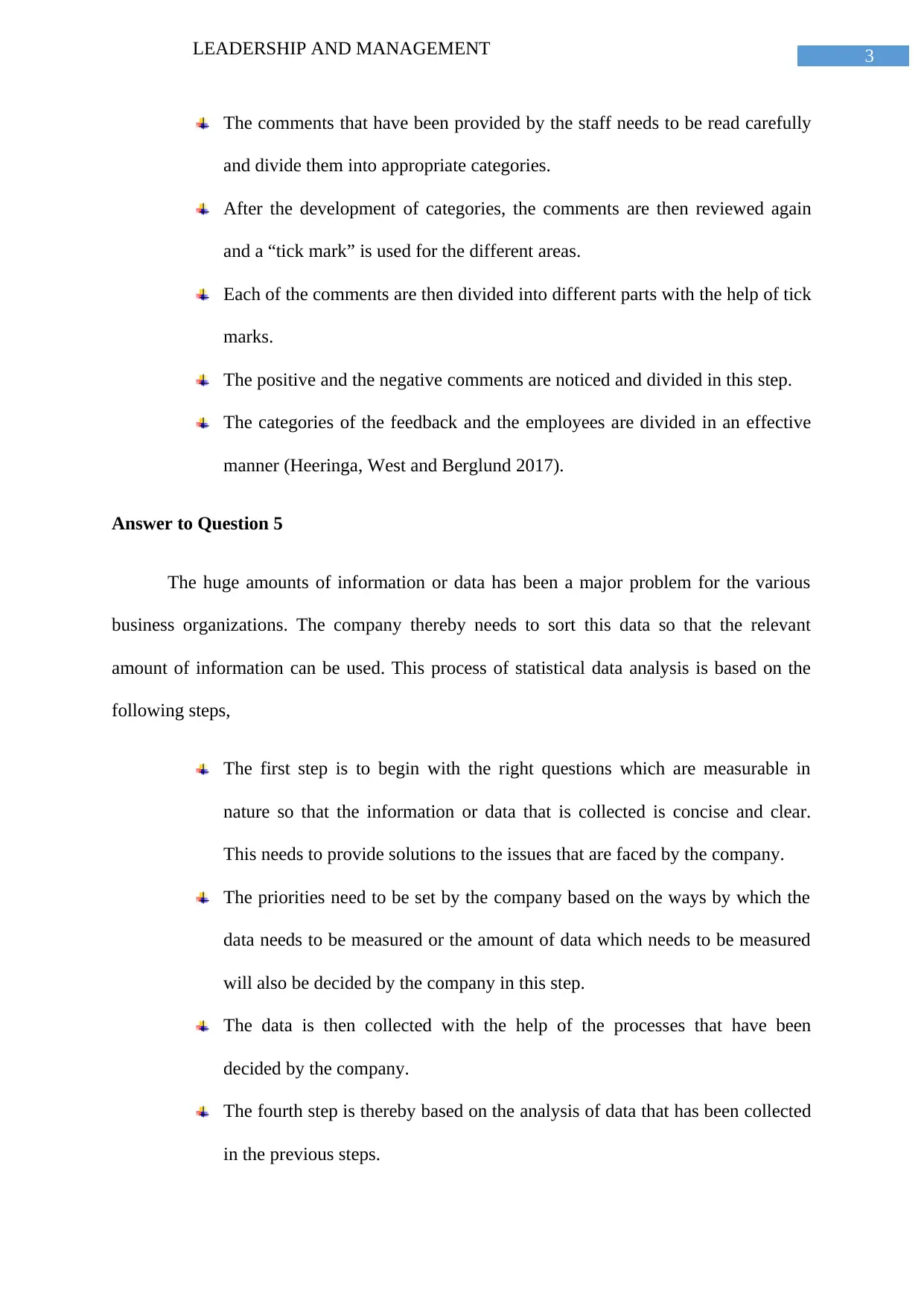
3LEADERSHIP AND MANAGEMENT
The comments that have been provided by the staff needs to be read carefully
and divide them into appropriate categories.
After the development of categories, the comments are then reviewed again
and a “tick mark” is used for the different areas.
Each of the comments are then divided into different parts with the help of tick
marks.
The positive and the negative comments are noticed and divided in this step.
The categories of the feedback and the employees are divided in an effective
manner (Heeringa, West and Berglund 2017).
Answer to Question 5
The huge amounts of information or data has been a major problem for the various
business organizations. The company thereby needs to sort this data so that the relevant
amount of information can be used. This process of statistical data analysis is based on the
following steps,
The first step is to begin with the right questions which are measurable in
nature so that the information or data that is collected is concise and clear.
This needs to provide solutions to the issues that are faced by the company.
The priorities need to be set by the company based on the ways by which the
data needs to be measured or the amount of data which needs to be measured
will also be decided by the company in this step.
The data is then collected with the help of the processes that have been
decided by the company.
The fourth step is thereby based on the analysis of data that has been collected
in the previous steps.
The comments that have been provided by the staff needs to be read carefully
and divide them into appropriate categories.
After the development of categories, the comments are then reviewed again
and a “tick mark” is used for the different areas.
Each of the comments are then divided into different parts with the help of tick
marks.
The positive and the negative comments are noticed and divided in this step.
The categories of the feedback and the employees are divided in an effective
manner (Heeringa, West and Berglund 2017).
Answer to Question 5
The huge amounts of information or data has been a major problem for the various
business organizations. The company thereby needs to sort this data so that the relevant
amount of information can be used. This process of statistical data analysis is based on the
following steps,
The first step is to begin with the right questions which are measurable in
nature so that the information or data that is collected is concise and clear.
This needs to provide solutions to the issues that are faced by the company.
The priorities need to be set by the company based on the ways by which the
data needs to be measured or the amount of data which needs to be measured
will also be decided by the company in this step.
The data is then collected with the help of the processes that have been
decided by the company.
The fourth step is thereby based on the analysis of data that has been collected
in the previous steps.
Paraphrase This Document
Need a fresh take? Get an instant paraphrase of this document with our AI Paraphraser
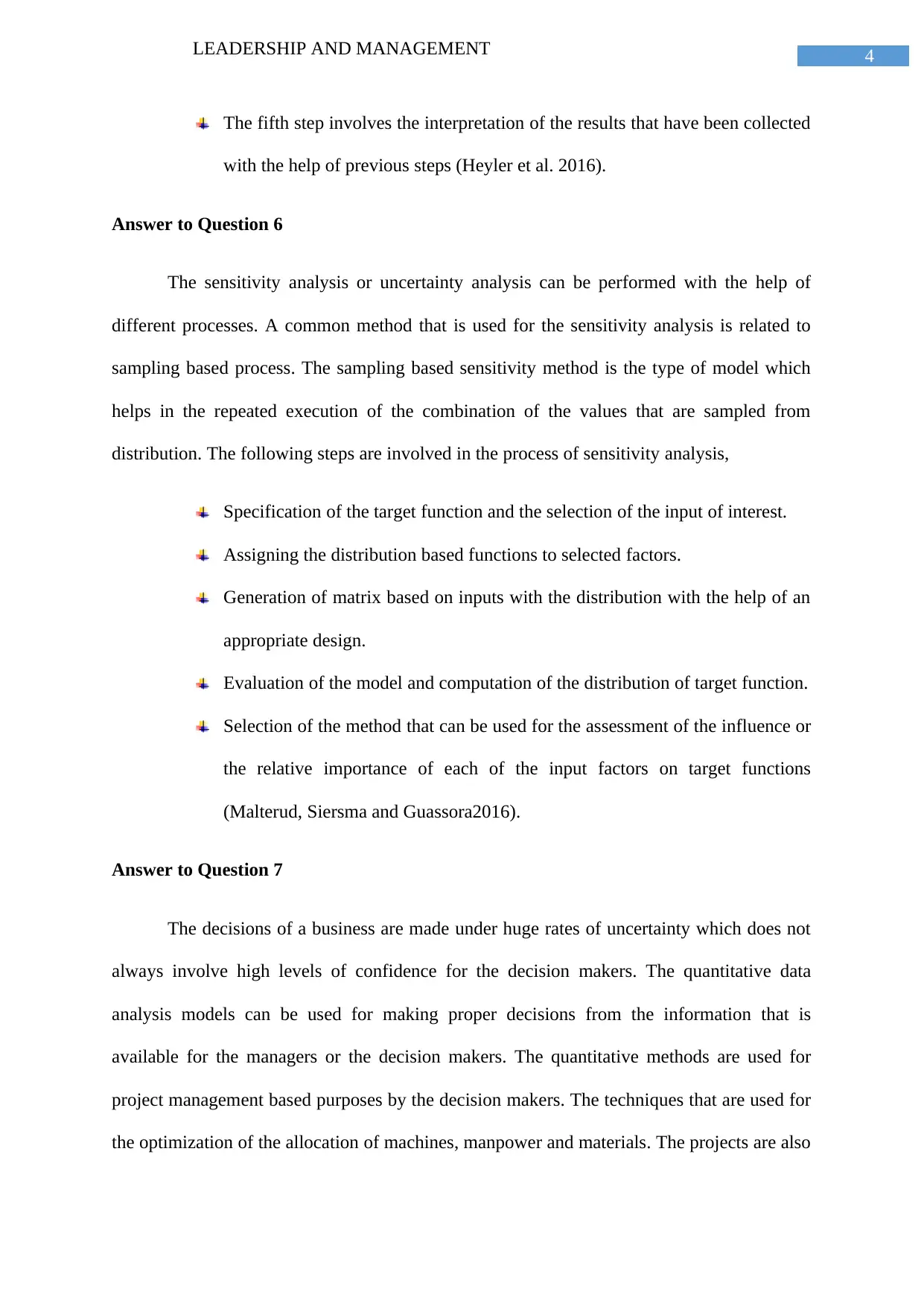
4LEADERSHIP AND MANAGEMENT
The fifth step involves the interpretation of the results that have been collected
with the help of previous steps (Heyler et al. 2016).
Answer to Question 6
The sensitivity analysis or uncertainty analysis can be performed with the help of
different processes. A common method that is used for the sensitivity analysis is related to
sampling based process. The sampling based sensitivity method is the type of model which
helps in the repeated execution of the combination of the values that are sampled from
distribution. The following steps are involved in the process of sensitivity analysis,
Specification of the target function and the selection of the input of interest.
Assigning the distribution based functions to selected factors.
Generation of matrix based on inputs with the distribution with the help of an
appropriate design.
Evaluation of the model and computation of the distribution of target function.
Selection of the method that can be used for the assessment of the influence or
the relative importance of each of the input factors on target functions
(Malterud, Siersma and Guassora2016).
Answer to Question 7
The decisions of a business are made under huge rates of uncertainty which does not
always involve high levels of confidence for the decision makers. The quantitative data
analysis models can be used for making proper decisions from the information that is
available for the managers or the decision makers. The quantitative methods are used for
project management based purposes by the decision makers. The techniques that are used for
the optimization of the allocation of machines, manpower and materials. The projects are also
The fifth step involves the interpretation of the results that have been collected
with the help of previous steps (Heyler et al. 2016).
Answer to Question 6
The sensitivity analysis or uncertainty analysis can be performed with the help of
different processes. A common method that is used for the sensitivity analysis is related to
sampling based process. The sampling based sensitivity method is the type of model which
helps in the repeated execution of the combination of the values that are sampled from
distribution. The following steps are involved in the process of sensitivity analysis,
Specification of the target function and the selection of the input of interest.
Assigning the distribution based functions to selected factors.
Generation of matrix based on inputs with the distribution with the help of an
appropriate design.
Evaluation of the model and computation of the distribution of target function.
Selection of the method that can be used for the assessment of the influence or
the relative importance of each of the input factors on target functions
(Malterud, Siersma and Guassora2016).
Answer to Question 7
The decisions of a business are made under huge rates of uncertainty which does not
always involve high levels of confidence for the decision makers. The quantitative data
analysis models can be used for making proper decisions from the information that is
available for the managers or the decision makers. The quantitative methods are used for
project management based purposes by the decision makers. The techniques that are used for
the optimization of the allocation of machines, manpower and materials. The projects are also
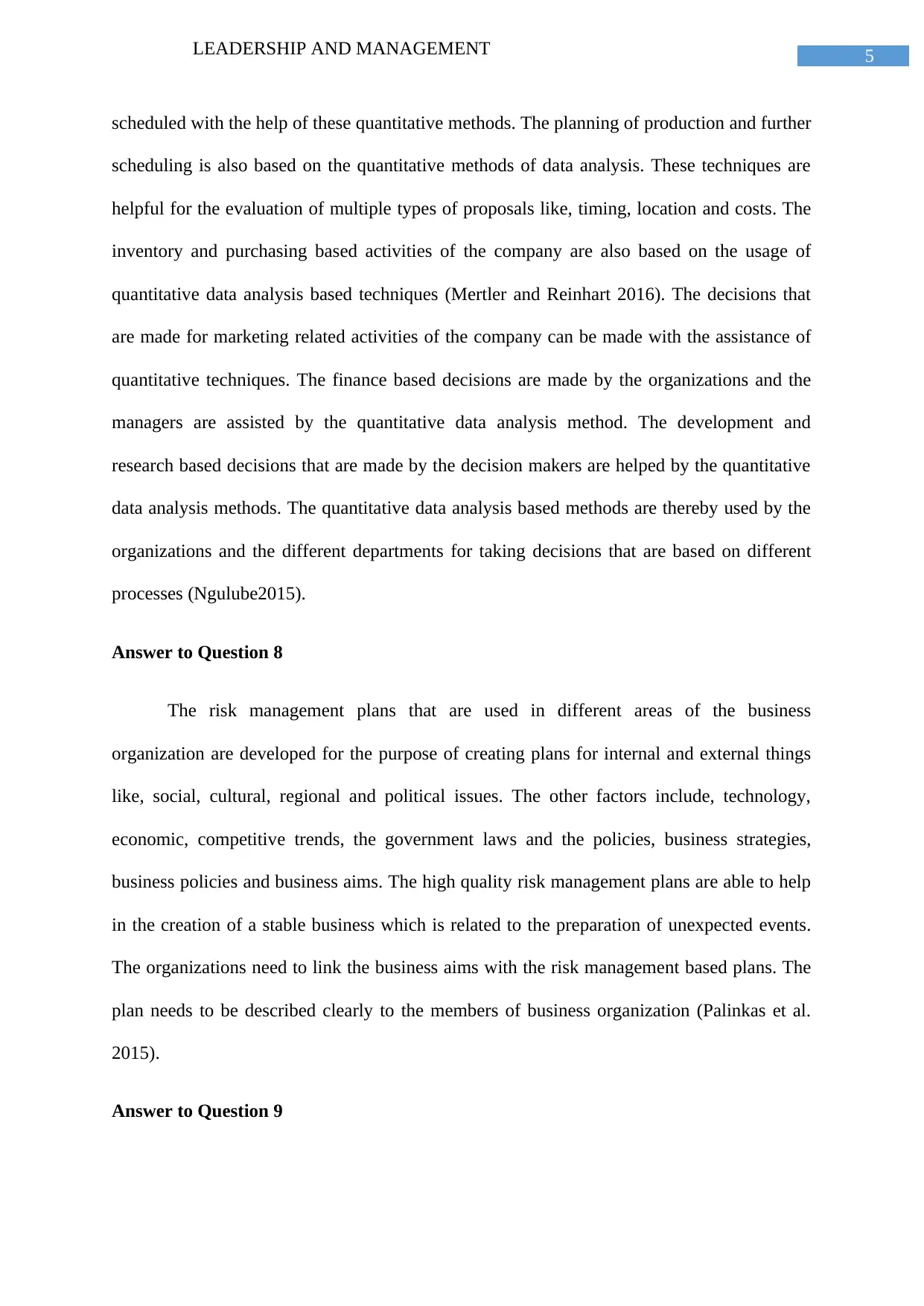
5LEADERSHIP AND MANAGEMENT
scheduled with the help of these quantitative methods. The planning of production and further
scheduling is also based on the quantitative methods of data analysis. These techniques are
helpful for the evaluation of multiple types of proposals like, timing, location and costs. The
inventory and purchasing based activities of the company are also based on the usage of
quantitative data analysis based techniques (Mertler and Reinhart 2016). The decisions that
are made for marketing related activities of the company can be made with the assistance of
quantitative techniques. The finance based decisions are made by the organizations and the
managers are assisted by the quantitative data analysis method. The development and
research based decisions that are made by the decision makers are helped by the quantitative
data analysis methods. The quantitative data analysis based methods are thereby used by the
organizations and the different departments for taking decisions that are based on different
processes (Ngulube2015).
Answer to Question 8
The risk management plans that are used in different areas of the business
organization are developed for the purpose of creating plans for internal and external things
like, social, cultural, regional and political issues. The other factors include, technology,
economic, competitive trends, the government laws and the policies, business strategies,
business policies and business aims. The high quality risk management plans are able to help
in the creation of a stable business which is related to the preparation of unexpected events.
The organizations need to link the business aims with the risk management based plans. The
plan needs to be described clearly to the members of business organization (Palinkas et al.
2015).
Answer to Question 9
scheduled with the help of these quantitative methods. The planning of production and further
scheduling is also based on the quantitative methods of data analysis. These techniques are
helpful for the evaluation of multiple types of proposals like, timing, location and costs. The
inventory and purchasing based activities of the company are also based on the usage of
quantitative data analysis based techniques (Mertler and Reinhart 2016). The decisions that
are made for marketing related activities of the company can be made with the assistance of
quantitative techniques. The finance based decisions are made by the organizations and the
managers are assisted by the quantitative data analysis method. The development and
research based decisions that are made by the decision makers are helped by the quantitative
data analysis methods. The quantitative data analysis based methods are thereby used by the
organizations and the different departments for taking decisions that are based on different
processes (Ngulube2015).
Answer to Question 8
The risk management plans that are used in different areas of the business
organization are developed for the purpose of creating plans for internal and external things
like, social, cultural, regional and political issues. The other factors include, technology,
economic, competitive trends, the government laws and the policies, business strategies,
business policies and business aims. The high quality risk management plans are able to help
in the creation of a stable business which is related to the preparation of unexpected events.
The organizations need to link the business aims with the risk management based plans. The
plan needs to be described clearly to the members of business organization (Palinkas et al.
2015).
Answer to Question 9
⊘ This is a preview!⊘
Do you want full access?
Subscribe today to unlock all pages.

Trusted by 1+ million students worldwide
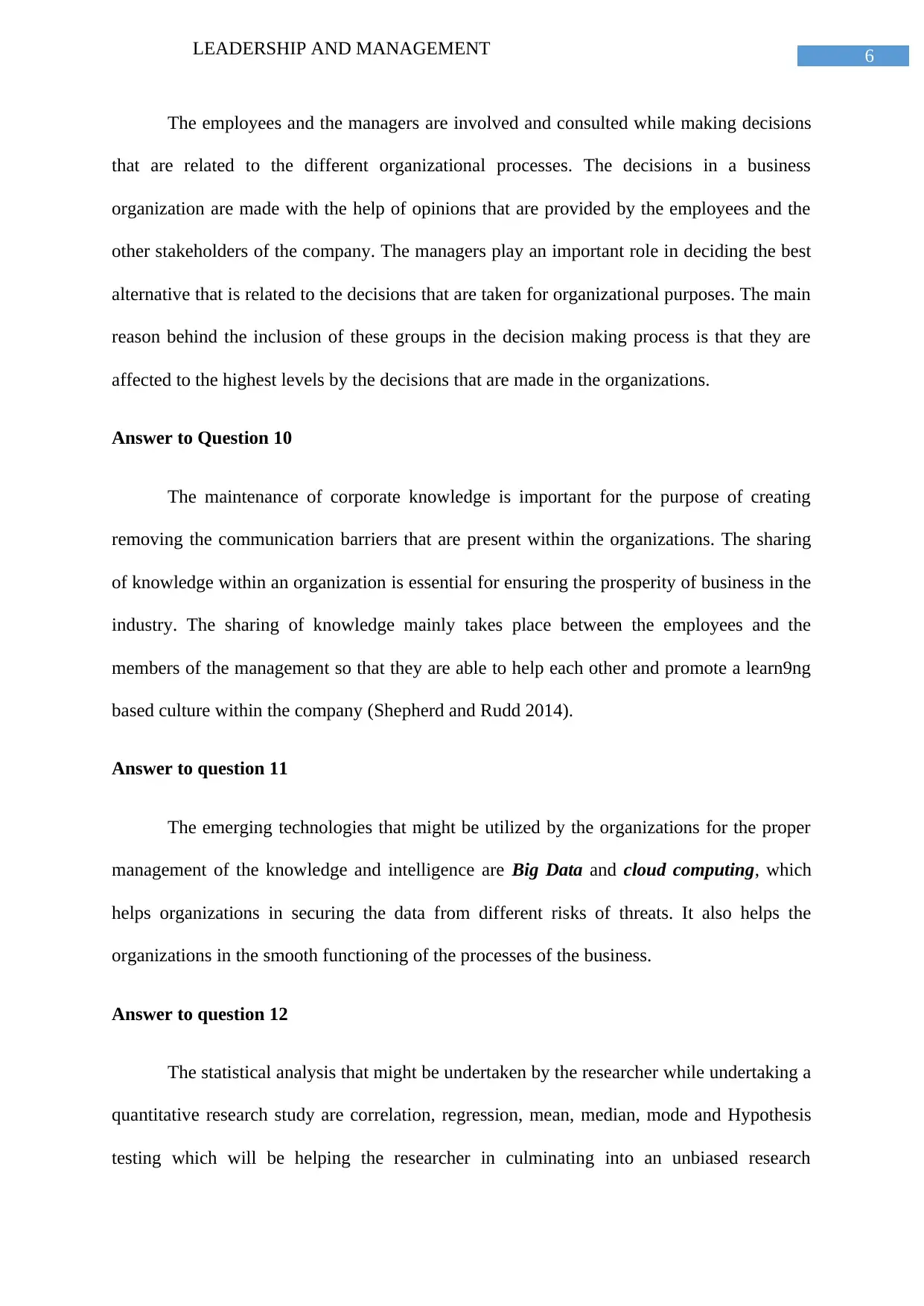
6LEADERSHIP AND MANAGEMENT
The employees and the managers are involved and consulted while making decisions
that are related to the different organizational processes. The decisions in a business
organization are made with the help of opinions that are provided by the employees and the
other stakeholders of the company. The managers play an important role in deciding the best
alternative that is related to the decisions that are taken for organizational purposes. The main
reason behind the inclusion of these groups in the decision making process is that they are
affected to the highest levels by the decisions that are made in the organizations.
Answer to Question 10
The maintenance of corporate knowledge is important for the purpose of creating
removing the communication barriers that are present within the organizations. The sharing
of knowledge within an organization is essential for ensuring the prosperity of business in the
industry. The sharing of knowledge mainly takes place between the employees and the
members of the management so that they are able to help each other and promote a learn9ng
based culture within the company (Shepherd and Rudd 2014).
Answer to question 11
The emerging technologies that might be utilized by the organizations for the proper
management of the knowledge and intelligence are Big Data and cloud computing, which
helps organizations in securing the data from different risks of threats. It also helps the
organizations in the smooth functioning of the processes of the business.
Answer to question 12
The statistical analysis that might be undertaken by the researcher while undertaking a
quantitative research study are correlation, regression, mean, median, mode and Hypothesis
testing which will be helping the researcher in culminating into an unbiased research
The employees and the managers are involved and consulted while making decisions
that are related to the different organizational processes. The decisions in a business
organization are made with the help of opinions that are provided by the employees and the
other stakeholders of the company. The managers play an important role in deciding the best
alternative that is related to the decisions that are taken for organizational purposes. The main
reason behind the inclusion of these groups in the decision making process is that they are
affected to the highest levels by the decisions that are made in the organizations.
Answer to Question 10
The maintenance of corporate knowledge is important for the purpose of creating
removing the communication barriers that are present within the organizations. The sharing
of knowledge within an organization is essential for ensuring the prosperity of business in the
industry. The sharing of knowledge mainly takes place between the employees and the
members of the management so that they are able to help each other and promote a learn9ng
based culture within the company (Shepherd and Rudd 2014).
Answer to question 11
The emerging technologies that might be utilized by the organizations for the proper
management of the knowledge and intelligence are Big Data and cloud computing, which
helps organizations in securing the data from different risks of threats. It also helps the
organizations in the smooth functioning of the processes of the business.
Answer to question 12
The statistical analysis that might be undertaken by the researcher while undertaking a
quantitative research study are correlation, regression, mean, median, mode and Hypothesis
testing which will be helping the researcher in culminating into an unbiased research
Paraphrase This Document
Need a fresh take? Get an instant paraphrase of this document with our AI Paraphraser
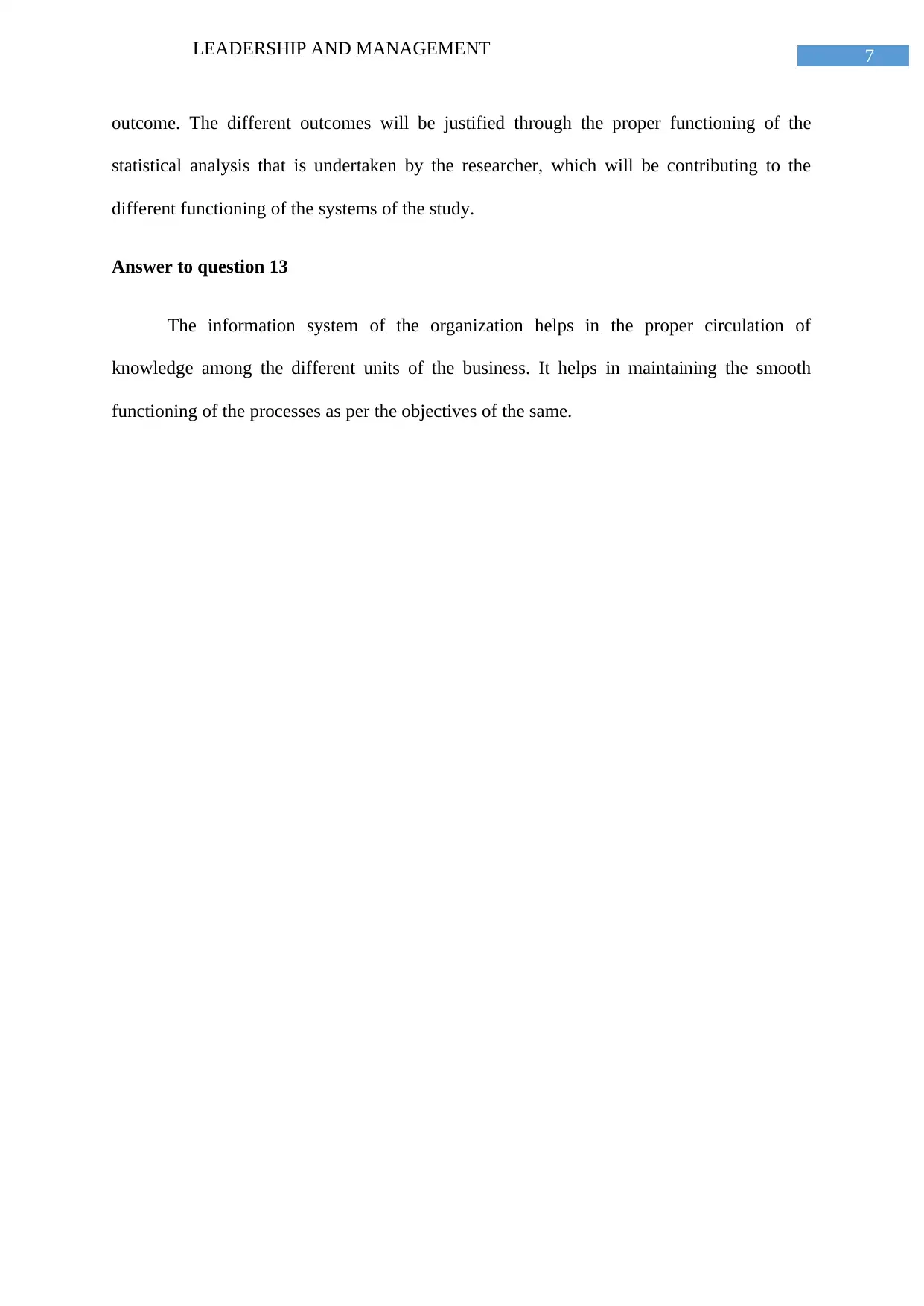
7LEADERSHIP AND MANAGEMENT
outcome. The different outcomes will be justified through the proper functioning of the
statistical analysis that is undertaken by the researcher, which will be contributing to the
different functioning of the systems of the study.
Answer to question 13
The information system of the organization helps in the proper circulation of
knowledge among the different units of the business. It helps in maintaining the smooth
functioning of the processes as per the objectives of the same.
outcome. The different outcomes will be justified through the proper functioning of the
statistical analysis that is undertaken by the researcher, which will be contributing to the
different functioning of the systems of the study.
Answer to question 13
The information system of the organization helps in the proper circulation of
knowledge among the different units of the business. It helps in maintaining the smooth
functioning of the processes as per the objectives of the same.
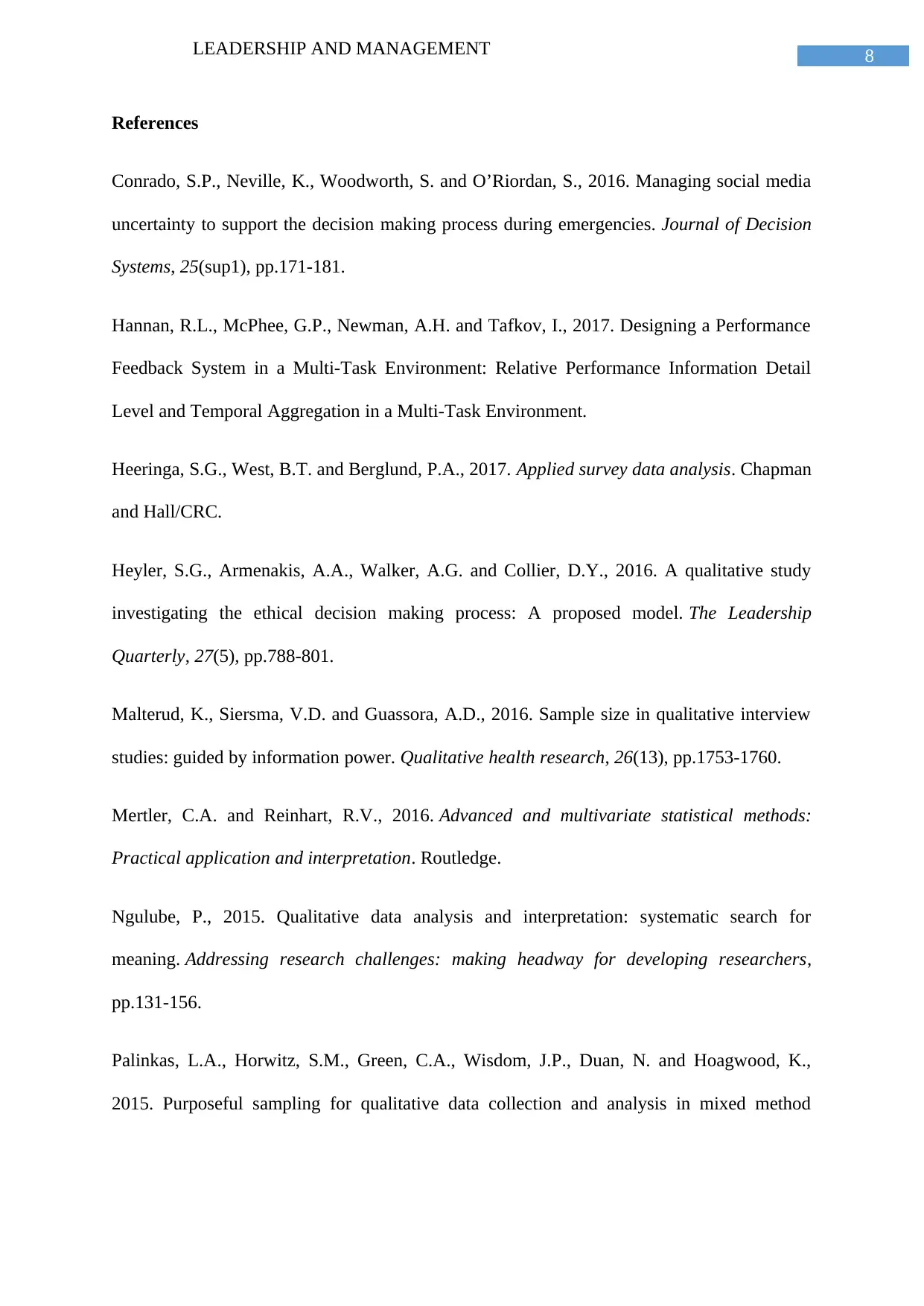
8LEADERSHIP AND MANAGEMENT
References
Conrado, S.P., Neville, K., Woodworth, S. and O’Riordan, S., 2016. Managing social media
uncertainty to support the decision making process during emergencies. Journal of Decision
Systems, 25(sup1), pp.171-181.
Hannan, R.L., McPhee, G.P., Newman, A.H. and Tafkov, I., 2017. Designing a Performance
Feedback System in a Multi-Task Environment: Relative Performance Information Detail
Level and Temporal Aggregation in a Multi-Task Environment.
Heeringa, S.G., West, B.T. and Berglund, P.A., 2017. Applied survey data analysis. Chapman
and Hall/CRC.
Heyler, S.G., Armenakis, A.A., Walker, A.G. and Collier, D.Y., 2016. A qualitative study
investigating the ethical decision making process: A proposed model. The Leadership
Quarterly, 27(5), pp.788-801.
Malterud, K., Siersma, V.D. and Guassora, A.D., 2016. Sample size in qualitative interview
studies: guided by information power. Qualitative health research, 26(13), pp.1753-1760.
Mertler, C.A. and Reinhart, R.V., 2016. Advanced and multivariate statistical methods:
Practical application and interpretation. Routledge.
Ngulube, P., 2015. Qualitative data analysis and interpretation: systematic search for
meaning. Addressing research challenges: making headway for developing researchers,
pp.131-156.
Palinkas, L.A., Horwitz, S.M., Green, C.A., Wisdom, J.P., Duan, N. and Hoagwood, K.,
2015. Purposeful sampling for qualitative data collection and analysis in mixed method
References
Conrado, S.P., Neville, K., Woodworth, S. and O’Riordan, S., 2016. Managing social media
uncertainty to support the decision making process during emergencies. Journal of Decision
Systems, 25(sup1), pp.171-181.
Hannan, R.L., McPhee, G.P., Newman, A.H. and Tafkov, I., 2017. Designing a Performance
Feedback System in a Multi-Task Environment: Relative Performance Information Detail
Level and Temporal Aggregation in a Multi-Task Environment.
Heeringa, S.G., West, B.T. and Berglund, P.A., 2017. Applied survey data analysis. Chapman
and Hall/CRC.
Heyler, S.G., Armenakis, A.A., Walker, A.G. and Collier, D.Y., 2016. A qualitative study
investigating the ethical decision making process: A proposed model. The Leadership
Quarterly, 27(5), pp.788-801.
Malterud, K., Siersma, V.D. and Guassora, A.D., 2016. Sample size in qualitative interview
studies: guided by information power. Qualitative health research, 26(13), pp.1753-1760.
Mertler, C.A. and Reinhart, R.V., 2016. Advanced and multivariate statistical methods:
Practical application and interpretation. Routledge.
Ngulube, P., 2015. Qualitative data analysis and interpretation: systematic search for
meaning. Addressing research challenges: making headway for developing researchers,
pp.131-156.
Palinkas, L.A., Horwitz, S.M., Green, C.A., Wisdom, J.P., Duan, N. and Hoagwood, K.,
2015. Purposeful sampling for qualitative data collection and analysis in mixed method
⊘ This is a preview!⊘
Do you want full access?
Subscribe today to unlock all pages.

Trusted by 1+ million students worldwide

9LEADERSHIP AND MANAGEMENT
implementation research. Administration and Policy in Mental Health and Mental Health
Services Research, 42(5), pp.533-544.
Shepherd, N.G. and Rudd, J.M., 2014. The influence of context on the strategic decision‐
making process: A review of the literature. International Journal of Management
Reviews, 16(3), pp.340-364.
implementation research. Administration and Policy in Mental Health and Mental Health
Services Research, 42(5), pp.533-544.
Shepherd, N.G. and Rudd, J.M., 2014. The influence of context on the strategic decision‐
making process: A review of the literature. International Journal of Management
Reviews, 16(3), pp.340-364.
1 out of 10
Related Documents
Your All-in-One AI-Powered Toolkit for Academic Success.
+13062052269
info@desklib.com
Available 24*7 on WhatsApp / Email
![[object Object]](/_next/static/media/star-bottom.7253800d.svg)
Unlock your academic potential
Copyright © 2020–2025 A2Z Services. All Rights Reserved. Developed and managed by ZUCOL.





